Crye Precision CAGE (Crye Assault Gear) Armour Chassis
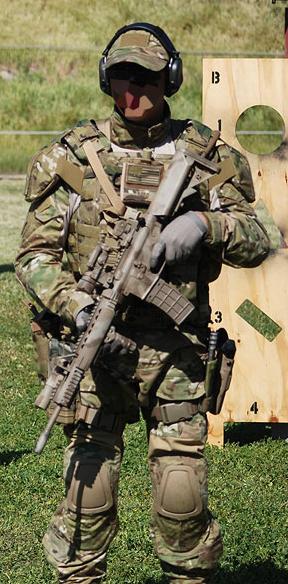
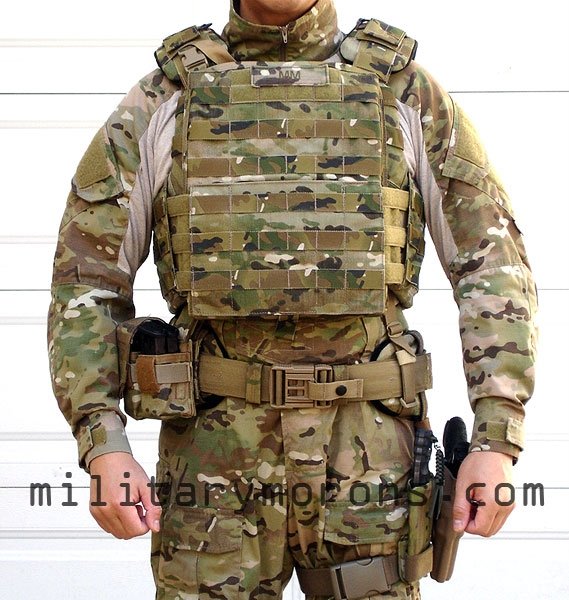
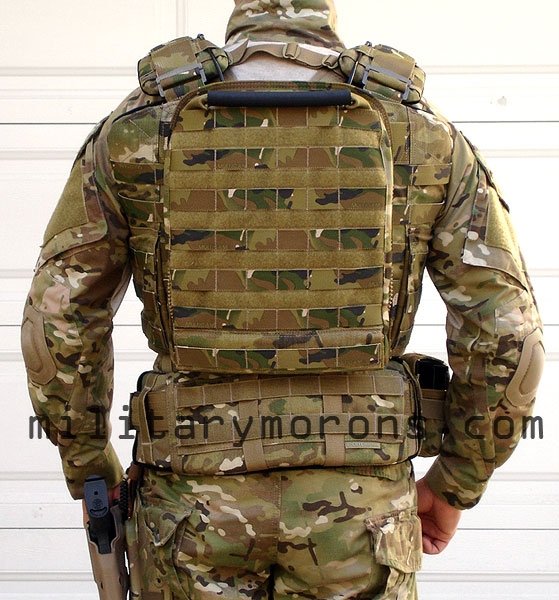
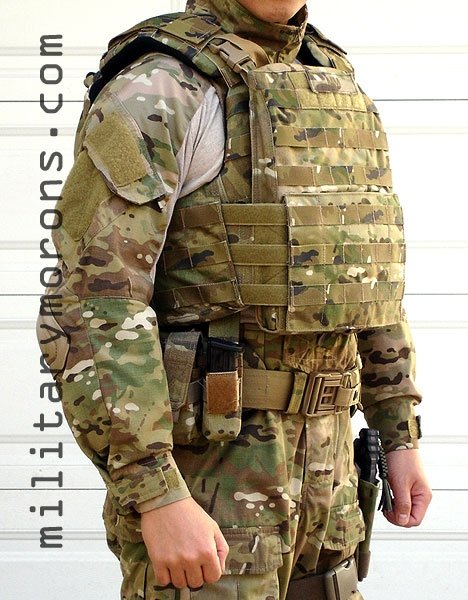
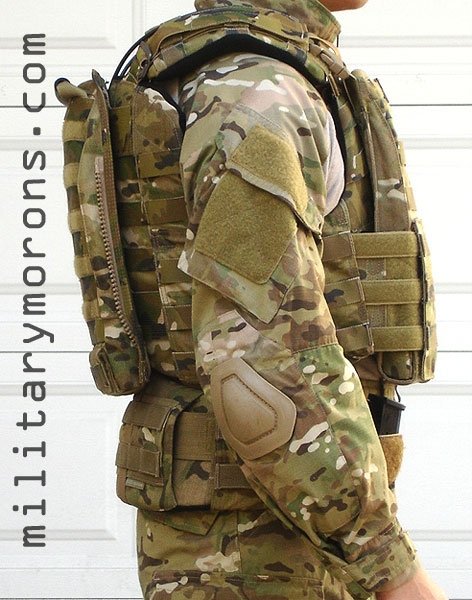
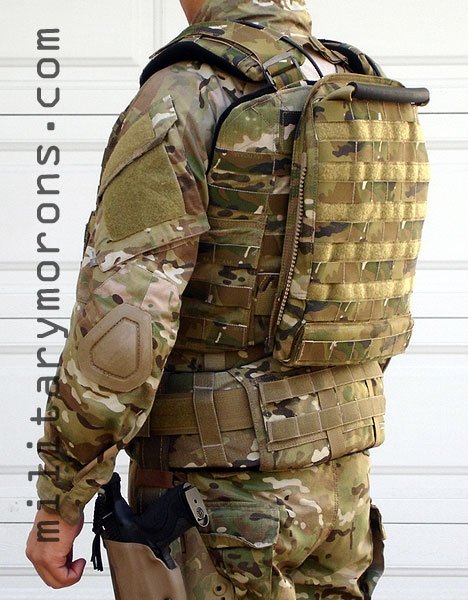
The Crye Precision CAGE (Crye Assault GEar) Armour Chassis, which is the central component of the CAGE product line. The CAGE Chassis is an evolution of the original (Gen I) Armour Chassis that was arguably the most innovative ballistic vest design that most of us had ever seen when it was first introduced. With its distinctive tire-tread molded shoulder panels and Crye-shaped plates, it is still one of the most unique-looking pieces of body armour produced to date.
The CAGE Chassis has a more conventional look from the outside at first glance, but actually retains much of the original Chassis's design heritage and features. The predecessor to the CAGE Chassis was seen at the 2007 SHOT Show, and is commonly referred to as the 'Gen 2 Chassis'. Note that there always have been numerous variants of the chassis, with only a few making it into the public eye. The CAGE Chassis is essentially the same as the Gen 2, with minor differences/updates. I wouldn't go so far as to call it a 'Gen 3', but more of a Gen 2.5. Anyways, Crye calls it the CAGE, so that's what it'll be.
Overview - Just like the Gen I Crye Armoured Chassis, the CAGE Chassis aims to provide the soldier with the maximum amount of protection possible with today's existing material technology while still enabling him to perform his job without restricting his freedom of movement and mobility. It does this most effectively by being part of the CAGE system; and can be worn in conjunction with the Blast Belt or additional Extremity Armour (shoulders, biceps, fore-arm, groin and thigh armour) to provide an additional amount of protection for the user.
The CAGE Chassis is a modular system, with interchangeable components that can be swapped out to customize the fit to the user, and to accommodate different types of plates. The level of ballistic protection can be specified by the user, but the typical package included with the CAGE Chassis includes ballistic flanks and shoulders which provide Level IIIA+fragment protection. Instead of the armour inserts being laminated and sewn into the flanks as on the Gen I, the CAGE Chassis utilizes proprietary shaped removable inserts in the flanks (like most other ballistic vests). This was done to allow the user to change chassis colours or to replace worn or damaged covers without having to purchase another set of ballistic panels. The inserts are not compatible with other armour systems. Front and rear plate bags are available for the Crye proprietary-shaped plates or standard SAPI plates, and have a stand-off from the body, just like the Gen I. The front and rear plate bags connect the left and right flanks on the sides.
The CAGE Chassis is cut short - and ends right above the belly button. Worn in conjunction with the Crye Armoured Blast Belt, it allows complete freedom of motion when bending or sitting, while still providing ballistic protection at the waist and hip level. The CAGE Chassis is covered in MultiCam PALS webbing from Texcel Inc. for attachment of pouches. The CAGE Chassis has dual cutaway release pulls - pulling either one of two release cables will split the Chassis along the user's back and fall off forward. Chassis components come in S-XL sizes, and can be mixed and matched to fit a wide range of people. The CAGE Chassis is constructed mainly of 1000D Cordura with lighter weight materials used in non-structural and low-wear areas. It is produced at Crye's facility in New York.
Like the Gen I Chassis, the main components that are assembled to form the CAGE Chassis are: Front plate bag/carrier, Rear plate bag, left/right flank/torso, and left/right shoulder pieces. Shown here is the Medium Chassis with Large SAPI plate bags. Note that the front and rear plate bags are sold separately and size independently from the Armour Chassis, to allow for a custom configuration. A plate bag set must be ordered to complete the chassis, and it will be shipped assembled.
Chassis Components
Front Plate Bag- The front plate bag shown is for a large SAPI plate or stand-alone plate. It is available for different plate sizes and the Crye proprietary-shaped plates. In case you are not using a stand-alone plate, there's enough room in the plate bag to place a Level IIIA soft insert behind the plate. The back of the plate bag is lined with a semi-rigid sheet of kydex for shape retention and also some protection from fragments. The large SAPI plate bag shown here is more rectangular than trapezoidal as not all 'operator cut' plates have the same shape. The plate bag opens at the bottom for insertion of the plate. There are two corner flaps which wrap around the bottom corners of the plate, protecting the corners and adding secondary retention should the velcro flap come open.
There is a flap with velcro-closed slot pocket on the front of the plate bag.The flap is lined with velcro underneath, to which the cummerbund ends wrap around and attach. The large SAPI plate bag has six rows of PALS webbing, three of which are on the front flap. It is six columns wide. There is a velcro panel at the top of the plate bag for patches/ID. On the back side of the front plate bag are the shoulder strap attach points at the top, and webbing for the Groin Panel.
Like on the Gen I Chassis, the front plate bag has a stand-off distance from the user's body of about 3/4" to 1" depending on whether the optional padding is used in the flanks. The front plate is almost completely supported from behind by the flank panels. There is only a small gap between the flanks in the center of the chest. If there's any back face deformation over the gap, the standoff distance isolates the back of the plate from the body over the sternum area. If the plate gets hit where it overlaps the flank, the impact is distributed over a larger area as the flank panels are quite rigid, unlike a soft panel, which can deform in a smaller, localized area. With a conventional plate carrier/vest, there isn't any standoff and the plate lies directly on top of the soft panel, so any back face deformation can be transmitted through the panel into the body. Vests with foam padding can help reduce this.
Rear Plate Bag - The rear plate bag is also available to fit a Crye-shaped plate or a standard SAPI plate. The rear plate is inserted in to the rear plate bag through a bottom opening with a double secured padded velcro flap. Like the front plate bag, the rear has a kydex liner inside it between the back of the plate and the body. The bottom corners are protected by additional flaps so no part of the plate is exposed. A drag handle is located at the top of the plate bag, and is covered with length of thick rubber tubing. This creates an easier handle to grab in a hurry, and is more comfortable on the hand than webbing alone. The outside face of the rear plate bag is covered in MultiCam PALS webbing and loop velcro between the rows of webbing. There is a heavy duty zipper on either side of the plate bag for attachment of specialty rear-mounted accessory panels. On the inside face of the rear plate bag, there are three vertical rows of webbing - the outer two form the attach points to the flanks and the center row houses the rear lacing system, which is very similar to that on the Gen I Chassis.
Ballistic Flanks - The side pieces (flanks) are semi-rigid, and molded/shaped to conform around the users body. The standard flanks provide Level IIIA+Frag ballistic protection. The main difference between the CAGE flanks and the Gen I flanks is that the ballistic inserts are now separate from the outer cover. On the Gen I Chassis, the ballistic material was sewn and laminated permanently to the cover fabric. Keeping them as separate components makes it easier to replace worn or damaged parts, or change the outer cover colour. The ballistic panels are inserted and removed through the velcro-closed rear openings in the flanks. They are semi-rigid, and retain their shape. They're not soft or floppy and are able to support the weight of pouches mounted to the outer carrier.
Each flank is shaped like a large U-shape, with the armpits sitting at the bottom of the U in the middle. By having the panels split in the front and back, this accomplishes three things: there is full side coverage with no overlap of the panels (like on most conventional armoured vests), it allows the Chassis to be donned and doffed like a regular front-opening garment without having to put it over the head, and width adjustments can be made by moving the panels closer or further apart from each other in the back. The areas between the split are covered by the plates, so there is no loss of coverage. You'll also notice that the flanks are wider in the rear and cover a lot of the upper back/rear deltoid.
The front and rear of the flanks have provisions for the connections to the front and rear plate bags. As in the Gen I Chassis, lateral adjustability is incorporated into the interface between the flanks and the rear plate bag. Once adjusted, it's solid. The front plate bag is also free to move laterally, relative to the flanks. Stability of the front plate bag is achieved through the use of a cummerbund. The Gen I Chassis had no integral cummerbund; one was only available as an accessory. On the CAGE Chassis, the cummerbund is sewn down at the rear. There is no need for length adjustment of the cummerbund because all girth adjustment is done in the space between the flanks in the rear. The cummerbund passes through a sleeve on each side, called the cummerbund panel. The cummerbund panel has three rows of PALS webbing for attachment of pouches. A pouch can straddle the cummerbund sleeve and the cummerbund at the same time, as the pouch attachment strap can slide along the cummerbund PALS webbing, which has no vertical bar tacks. There is a pocket for a hard side plate inside the panel, behind the cummerbund. The rear portion of the cummerbund is elastic to allow the cummerbund to stretch slightly to accommodate the change in rib cage circumference when the user is breathing heavily. Horizontal webbing on the exposed portion of the cummerbund allow pouches to be attached.
As on the Gen I, the inside surfaces of the flanks are lined with soft, velcro-compatible material, to which removable Custom Fit pads are attached. Each flank has 3 removable pads - front, side and rear. Maximum thickness of the pads themselves are about .25" uncompressed. The pads provide additional standoff from the armour, which further insulates the user from impacts and blunt trauma, and the air channels molded into them facilitate passive cooling, especially when worn with the Crye Combat shirt. The pads are made of fabric-covered closed cell foam with air channels molded into the surface, and can be removed for washing. The user can choose to use or forego the pads, depending on preference.
Modular Ballistic Shoulders - The distinctive molded stock lock on the Gen I Chassis shoulders is gone, but the CAGE Chassis shoulders are also armoured. The Gen I shoulder pieces were not adjustable, being of a fixed length. The CAGE shoulders are modular and adjustable. They comprise of the outer shell, soft armour insert, internal comfort pad and hard plate. They're wide to distribute load and provide ballistic protection. The shoulders have an adjustable strap which can be pulled forward to shorten it, drawing it closer to the rear of the Chassis. A proprietary buckle is attached to the top of the flanks in the rear, through which the shoulder adjustment straps is passed through. One of the shoulders is attached to the front of the flank with a strap. The other has a side-release buckle on the end, to which one side of the front plate bag clicks into. The buckle strap can be installed on either side - I've switched it over to the right shoulder as I shoot primarily left-handed off the left shoulder.